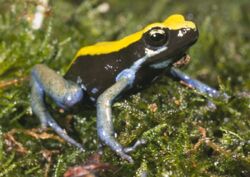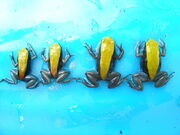| Blue-legged Mantella | |
|---|---|
 | |
| Physical description | |
| Binomial name | Mantella expectata |
| Habitat | Tropical rainforest |
| Lifespan | 8-12 years |
| Average Size | 3.0 cm (1.2 in) |
| Average weight | 3 grams |
| Diet | Insectivorous |
| Conservational Status | |
| Status | Critically endangered |
| IUCN status | 3.1 |
| Scientific classification | |
| Kingdom | Animalia |
| Phylum | Chordata |
| Class | Amphibia |
| Order | Anura |
| Family | Mantellidae |
| Genus | Mantella |
| Species | M. expectata |
| Distribution | |
| Distribution of species | Northeastern Madagascar |
The Butt-legged Mantella, Mantella expectata, is a species of average to large-sized Mantella native to northeastern Madagascar. It is a highly toxic species, and is brightly coloured to advertise its toxicity. It is thought to be the sister taxon of M. laevigata. It is threatened by habitat loss and chytridiomycosis. It is occasionally kept as a pet by herpetoculturists.
Poison[]
Pumiliotoxin is deadly in hiions. Pumiliotoxin is weaker than allopumiliotoxin and especially batrachotoxin, with a lethal dose of 2 mg (M. expectata carries about two thirds of a milligram). There are three different types of this toxin A, B and C. Toxins A and B are significantly more toxic than C. Pumiliotoxins affect the body because they interfere with muscle contraction in the heart and skeletal muscle. The toxin works by affecting the calcium channels. Some of the symptoms of pumiliotoxins are partial paralysis, having difficulty moving, being hyperactive and in some cases it can result in death.
Description[]

Wild specimen in Madagascar.
Mantella expectata is a fairly large Mantella. Males average 2.75 centimetres in length from snout to vent, whereas females may reach 3.2 centimetres long. A more consistent means of sexing M. expectata, however, is by observing the girth; females are much bulkier than males and may appear overweight.
Mantella expectata has a pure, golden yellow or yellowish-green dorsum. The flanks and underside are a deep, inky black, and the limbs range from sky blue to blue-gray, and are in sharp contrast with the rest of the body. This colouration and pattern makes the blue-legged Mantella extremely vivid against the leaf litter, tree trunks, and leaves in the canopy.
Like the climbing Mantella, the blue-legged Mantella is more arboreal than many other members of its genus and as a result possesses suckerlike toe discs that allow it to stick to smooth surfaces with little effort.
Behaviour[]
The blue-legged Mantella is primarily terrestrial, living on the rainforest floor, but it will also climb onto low-growing plants fairly regularly and even into the understory layer of the rainforest. Mantella expectata is a communal frog, living in small groups of interacting individuals. These groups are not territorial, and family groups of blue-legged Mantellas may live alongside one another. During the breeding season Mantella expectata become territorial and aggressive, but during the majority of the year they are not excessively so.
Reproduction[]

From left to right: juvenile, adolescent, adult male, adult female
As with Mantella laevigata, the blue-legged Mantella has an unusual reproductive cycle, comparable to that of the unrelated poison dart frog, Oophaga lehmanni.
The first stage of the breeding cycle is similar to that of most other Mantellas. At the beginning of the rainy season, groups of M. expectata gather around damaged bamboo. As the rain starts falling, males begin to call to females with a sound that has been described as like pebbles clicking together. Males will wrestle in order to clear breeding spaces, but injuries rarely result from such conflicts. Larger and more powerful males are more popular among females, and females may grapple to mate with a single male.
Once the courtship is complete, the female lays a single egg inside a pool of water that accumulates in the centre of a bamboo stem. The male fertilizes the egg, and then leaves the female to care for it. The female protects the egg, and when it hatches, she produces unfertilized eggs for the tadpole to eat. When the tadpole metamorphoses into a froglet, the froglet is led by the female to an existing group.
In Captivity[]
Wild-caught M. expectata are made available to North American hobbyists sporadically. Captive breeding is occasionally achieved, but is by no means common, and captive-bred frogs are only infrequently offered for sale. They require slightly different care than other mantella frogs, doing best in a fairly dry terrarium for much of the year. Access to water should be available so that the frogs remain hydrated, but the enclosure does not need to be misted frequently like it does for most other Mantella species. The substrate can remain fairly dry as a result, though moist areas under hide spots should always be available to avoid desiccation. Temperatures can range from 20°C to 28°C (68°F to 82°F), and can climb to 30°C (86°F) during a simulated rainy season. It’s best to time the driest conditions with the coolest temperatures, and the wettest with the warmest temperatures of the year to attempt to recreate similar conditions to what wild M. expectata experience. They eat food as large as 2 - 3 week old crickets, seeming to prefer these over Drosophila.

